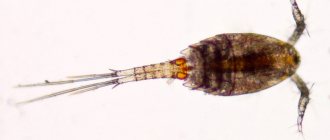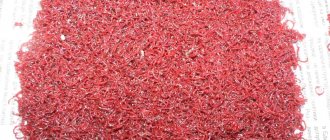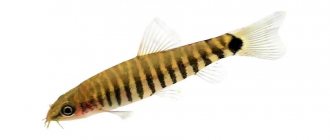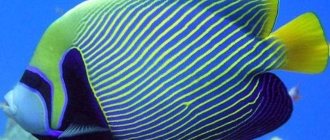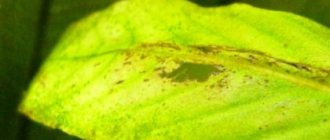To defrost or not? feeding
Like other foods for aquarium fish, Cyclops can be given in several ways:
1. Complete defrosting. You take aquarium water, throw a piece of food into it, let it sit and pour it back. However, this feeding option is not entirely suitable for small-sized food.
2. 2. Partial defrosting. Dip the Cyclops block into water. What dissolves is used as food for the fish.
3. No defrosting. If the number of inhabitants is large, you can safely throw a “tablet” of food into the water.
Rotifers DESCRIPTION BREEDING PHOTO AND VIDEO
Aren't cyclops pests?
In some cases they may be, so they should be used with caution. Sometimes they may feast on tiny, weaker fry. Initially feed the very tiny fry ciliates and newly hatched shrimp. As soon as they grow a little, they can safely be fed with cyclops. Larger fry and adult fish are not in danger from Cyclops.
Outside the aquarium, cyclops may be considered pests for other reasons. In some places and circumstances they can be an intermediate host for disease, including dracunculiasis disease. This is especially true in underdeveloped areas with poor sanitation.
What to do if fish do not pay attention to such food?
On forums, many aquarium owners complain that their fish do not pay enough attention to the food and it subsequently settles to the bottom. Many representatives of fish from 3 centimeters simply do not want to identify small food. You can deal with this problem as follows:
1. Put the fish on a hunger strike for several days, if this is a manifestation of “character”;
2. Let them get used to the new food, based on their reaction, alternate Cyclops with other foods;
3. Throw a solid piece from which the fish will pinch off the parts they need.
cyclops fish food photo
What are Cyclops?
Cyclops are tiny copepods that live in many freshwater and saltwater bodies. They get their name from the single eye located in the middle of their head. Another name often used to refer to this tiny crustacean is "Water Flea" due to the juvenile Cyclops' resemblance to land-dwelling fleas.
Cyclops range in length from 0.5 to 5 mm, have antennae, a segmented body and five pairs of legs. The anterior part of an adult is oval in shape and includes the head as well as the first five thoracic segments. The posterior section, known as the furca, is thinner and contains a sixth thoracic segment, four abdominal segments and two caudal appendages that project posteriorly. Cyclops larvae, known as nauplii, are free-swimming and lack segments. These are nauplii that resemble a flea.
The cyclops' body takes on its color, at least in part, from what it eats. Cyclops colors can be blue, green, orange and red. The single eye may be black, but is often red. They are omnivores, eating algae and a variety of other microscopic debris. On average they live for about three months. There are more females than males and they have paired egg sacs that are located on the back of their bodies. Under ideal conditions, Cyclops reproduces quickly.
Live fish food - Cyclops description
| Cyclops live in the same bodies of water as daphnia. With the onset of cold weather, when the water temperature in the reservoir drops, daphnia disappears, but Cyclops remains in small quantities almost throughout the winter. Many cyclops gather in reservoirs usually from March to May inclusive, and there are especially many of them in September and October. In the summer months, Cyclops is found much less frequently, and in some reservoirs it disappears altogether. Cyclops is a representative of the copepods. Unlike daphnia, it is somewhat smaller in size: its length reaches only 2 mm. The body of the Cyclops is segmented, pear-shaped, the abdomen is elongated in the form of a tail. The long antennae do not have branches, like those of daphnia. The nature of movement in water is also different. The movements of daphnia are slow, while the cyclops makes rapid leaps, quickly covering long distances in the water. A cyclops swims overturned on its back. The cyclops also has one eye, its body is devoid of a hard shell, which, combined with its tiny size, allows it to be fed to the smallest fish, as well as to growing fry. In terms of its qualities, Cyclops is an excellent live food. Dry cyclops are not used as food. A very valuable food is the Cyclops larva - nauplius, usually used to feed fry. Nauplii are so small that they are almost impossible to see with the naked eye. Quite often among the Cyclops one comes across another crustacean - Diaptomus. It has the same good feeding qualities, but most fish refuse it or eat it reluctantly. The methods for catching a cyclops in natural reservoirs, as well as its transportation and maintenance at home, are essentially the same as for daphnia. But compared to daphnia, Cyclops is more tenacious and does not die in large numbers either in the aquarium or in the vessels for storing it. To catch a cyclops, you must have a net made of thin but dense fabric, otherwise very small cyclops, as well as nauplii, will not be caught. |
For fishing, nets with fabric No. 28-32 are used, for catching larvae - fabric No. 64-76. It is recommended to catch crustaceans from spring, at a water temperature of 8 degrees, until February.
The net is made as follows: the rim has a diameter of 25-30 cm, and is made of stainless steel (rod with a diameter of 3-5 mm), a cone-shaped bag, 40-60 cm long. The handle has a length of 1.5-3 meters. When fishing, the net is moved in a figure-eight shape: curves are drawn without pressure and smoothly, and straight lines are drawn with pressure; with this movement, a whirlpool is created that is necessary for sucking in crustaceans. You cannot keep the net immersed in water for a long time, as this could leave the crustaceans in the net without oxygen and die.
Caught crustaceans must be examined in a white basin, since together with the crustaceans you can catch a large number of pests: dragonfly larvae, swimming beetles and others, which, once in the aquarium, will cause serious harm to its inhabitants.
Next, if necessary, the crustaceans are divided into fractions by size, the dead are removed and stored. Store Cyclops in a cool, dark place, such as a refrigerator, in a container with a large surface area, such as a basin. The water layer is 3-5 cm. When storing with a high layer of water, aeration is necessary.
Dead food must be removed. To do this, create a “vortex” in the water with a stick; the dead food is collected in a “slide” in the center of the vessel, from where it is easily removed with a hose.
Another way to remove dead cyclops: pour aquarium water into a 100-200 cm cubic jar with dark glass and add cyclops into it. Then the jar must be suspended in the aquarium 3-5 cm below the water level. All living cyclops will float into the light, dead ones will remain in the jar.
cyclops video
DAPHNIA FISH FOOD CULTURE DESCRIPTION TYPES FISHING CONTENTS PHOTO VIDEO
How to properly feed fish
Some beginners mistakenly think that their pets can handle large portions of live food. Actually this is not true. On the contrary, experts advise giving food to fish in small doses - as much as they need at a time. This rule is especially true when it comes to the aquarium in which the fry live and the larvae of Cyclops, which are called nauplii. The fact is that these creatures develop much faster and very soon change their status from edible prey to voracious predator. Therefore, never leave uneaten baby copepods in the aquarium.
Important! Experts advise alternating food for fish, avoiding monotony. At the same time, do not forget that domestic aquatic inhabitants can eat a lot, which is impractical
.
You should never overfeed your charges.
This approach will only harm them. During feeding, live and dried specimens are simply thrown into the aquarium. Frozen blocks must first be cut into portions with a knife or removed from the molds. This food cannot be defrosted - it is immediately given to the fish. Some aquarium beginners dip the edge of a frozen block into water. Familiarize yourself with the rules for caring for such common aquarium fish as: clownfish, veiltail, gura, guppy, barb, parrotfish, mollies, goldfish, swordtail, platie, zebrafish, betta, astronotus, lalius, minora, discus, arowana , surgeonfish, dario dario, angelfish, macropod, macracanthus, cichlids, rhodostomus and labeo.
When it melts, it releases food. But such manipulations are not welcomed by experienced fish owners. The fact is that such blocks are subject to oxidation, which harms the wards. Therefore, it is appropriate to place the food entirely in special feeders, and remove its remains in a timely manner.
Preparing live Daphnia food for the winter
If you decide to breed daphnia or other live food at home, then here are a few secrets of breeding and storing it for the winter.
A little dry cow manure is placed in a barrel of soft water and the crustaceans are released. They are fed with ordinary yeast, while the water is maintained in a state of slight turbidity. Using the drying method, daphnia is prepared for future use; at the beginning of summer, large crustaceans are selected for this purpose.
Aquarium fish do not reproduce and grow well if they are constantly fed dry food, so it is recommended to add vitamin D to dry daphnia. No more than two drops of an oily solution of vitamin D are mixed with one matchbox of dry daphnia. Also, instead of vitamin D, you can add fish oil to dry daphnia.
Food from powdered dry daphnia is poured into a feeder made of glass tubes floating on the surface of the aquarium. Cyclops and daphnia, as well as bloodworms, can be frozen for future use.
It is very good to feed aquarium fish with dry food, mixing it with shredded lettuce leaves. Fresh lettuce leaves are also nutritious for fish; before putting lettuce leaves into the aquarium, they should be scalded with hot water and cooled.
Live food tubifix and tubifex
Of course, both tubefix and tubifex are excellent food for aquarium fish after bloodworms. It is recommended to store it in the same way as bloodworm larvae in a saucer with water. It is recommended to change the water at least twice a day. Tubifex live for months under such storage conditions. The worm must be cut in advance of feeding, otherwise it will immediately burrow into the soil of the aquarium.
When washing the tubifix, if the sludge turns out to be dense enough and it is not possible to wash the worm, then in this case the sludge along with the worms is placed in a galvanized bucket and filled with cold water. The bucket is placed on a gas stove and heated slowly. Thus, the tubifex, escaping, floats to the surface of the water, where you can easily catch them.
Advantages and disadvantages
Cyclops food allows you to enhance the brightness of your pets' colors. Its nutritional value is on par with other crustaceans and is quite high. The protein content reaches 60%, and the fat content, on the contrary, is low. This type of live food will never make your fish overweight, since small products are easier to digest. In addition, the chitinous shell of the Cyclops is not digested and remains in the intestines as useful ballast, aiding in digestion.
There is only one disadvantage: the crustacean cannot be given alive, only frozen, otherwise the fish simply will not catch it.
